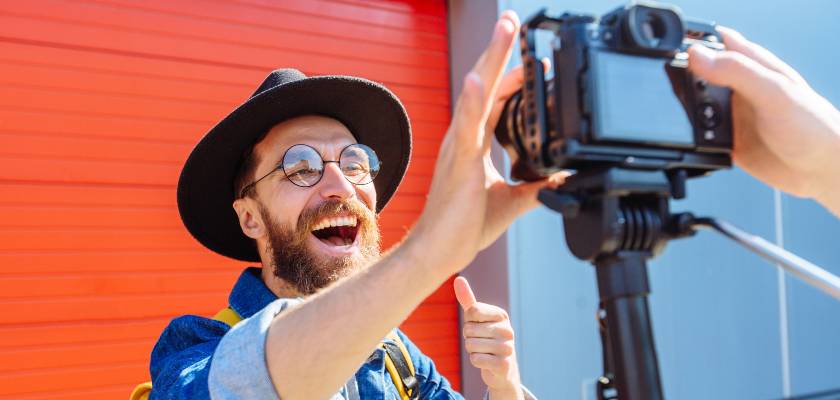
Influencer Marketing: The Shift from Celebrities to Micro-Influencers
Influencer marketing – it’s been a massive trend in the last few years, and that is not stopping any time soon. However, how we choose and relate to influencers is seeing a major shift. Influencer marketing was once an industry dominated by celebrities, but it has become one where micro-influencers are now making a big impact. But why are micro-influencers seeing a rise? Two words – engaged followers. Our digital marketing agency, Bold x Collective, has noted the significant impact of micro-influencers when it comes to launching B2C campaigns for our clients, and in this blog, we get into it.
This shift is truly reshaping how brands connect with their target audiences, offering new opportunities. Let’s get into the specifics!
The Rise of Micro-Influencers
Traditionally, influencer marketing was all about celebrities and influencers with millions of followers. These big names were the way to promote products and services. However, as authenticity rises in 2024, micro-influencers are becoming very important. These individuals are relatable – like regular people, unlike huge influencers and celebrities, who tend to be less relatable due to their status and “privilege,” as some individuals say on social media. Micro-influencers tend to have followers typically ranging from 1,000 to 100,000 followers. They make up for what they lack in sheer numbers in engagement and authenticity.
Authentic Engagement is key
As mentioned previously, a critical factor driving the shift toward micro-influencers is the desire for authenticity. In an era where consumers are bombarded with ads and filters, there’s a growing skepticism towards traditional advertising and celebrity-endorsed products. Micro-influencers, with their more relatable and personal content, offer a genuine connection that resonates with audiences. Their recommendations come across as more trustworthy, akin to advice from a friend rather than a sponsored ad.
In addition, micro-influencers typically have increased, positive engagement rates than the more famous influencers. This metric, which measures the level of interaction followers have with an influencer’s content (likes, comments, shares), is crucial for the success of influencer marketing campaigns. High engagement rates signal that an influencer’s content resonates with their audience, making them more likely to influence purchasing decisions.
Targeted Reach
Micro-influencers often cater to niche markets, making them invaluable for brands looking to target specific demographics. Their followers are typically highly engaged individuals who share a real interest in the influencer’s niche, whether it be fashion, fitness, technology, or any other industry; they are always focused on their niche. This targeted reach allows for more efficient marketing strategies, where brands can connect with an audience already predisposed to an interest in their products or services.
This is highly beneficial for marketers, especially in a cookie-less world. Targeting is becoming difficult in comparison to previous years, so in 2024, it’s key to find alternative strategies. In this case, an alternative strategy is working with micro-influencers that resonate with your product or service, as they have that niche, engaged audience.
Micro-Influencers Can Be Cost Effective
Did you know that collaborating with micro-influencers is often more cost-effective than engaging with celebrities? Their fees are usually much lower, making them accessible to smaller brands or those with limited marketing budgets. Once upon a time, influencer marketing was so expensive, and now it is no longer the case, which is excellent for smaller businesses. This cost advantage does not necessarily come at the expense of impact. Due to their high engagement rates, micro-influencer campaigns can yield a better return on investment (ROI), reaching a dedicated audience at a fraction of the cost!
Flexibility and Creativity
Micro-influencers tend to offer more flexibility and are more open to creative collaboration ideas. From our experience at our digital marketing agency, we see that they are always open-minded and willing to hear ideas from the brand to create an excellent end product. On the other hand, with celebrities who may have strict contract requirements and less availability, micro-influencers are generally more accessible and willing to co-create content that aligns with both the brand’s and their personal brand’s values. This flexibility can lead to more authentic and innovative marketing content! Audiences in 2024 love authenticity, that’s for sure!
Examples of Brands That Use Micro-Influencers
In the developing influencer marketing industry, numerous brands across various industries have used micro-influencers to connect with their target audiences in a more authentic and engaging way. These brands, including some of our own clients, have recognized that partnerships with micro-influencers can bring forth impressive results thanks to their high engagement rates, niche audiences, and authentic content. Here are a few examples we like to refer to.
First and foremost, Airbnb’s marketing strategies include utilizing micro-influencers to share their unique travel experiences, showcasing the diverse range of accommodations available on the platform. By showcasing personal stories and “hidden gems” discovered through their platform, Airbnb does an excellent job of encouraging their target audience to explore unique travel destinations, seamlessly promoting their app.
Next up, we have Daniel Wellington, a well-known watch brand. Daniel Wellington has achieved visibility and engagement across different demographics and interests by gifting watches to a wide array of micro-influencers and encouraging them to share their own stories and photos featuring the product. This user-generated content showcasing their watches in a positive way helps drive brand awareness and conversions.
HelloFresh is another great example; this meal kit company has partnered with micro-influencers to showcase the ease and convenience of their service. By having real people share their cooking experiences, including the unboxing process and the final meal, HelloFresh demonstrates the value of its product in everyday life, appealing directly to its target audience’s desire for simplicity and quality. We love the authenticity… and the unboxing, of course!
Lastly, there is Lululemon, a company that has always been phenomenal with its marketing. This athleisure brand uses micro-influencers within the fitness and wellness community to highlight their products in action. By partnering with yoga instructors, fitness trainers, and wellness coaches with a niche following, Lululemon can authentically engage with a health-conscious audience, demonstrating the versatility and quality of their apparel.
What Does the Future of Micro-Influencers Look Like?
As the influencer marketing industry continues to develop, the role of micro-influencers is expected to grow, per our agency’s research. We believe that brands will likely invest more in long-term relationships with influencers as they understand the value of building genuine connections with their audiences.
Additionally, the rise of social media platforms and changing algorithms will continue to play a key role in shaping the dynamics of influencer marketing. The shift towards micro-influencers also suggests an even bigger trend towards personalization and authenticity in marketing, which will also be important in 2024. Consumers are increasingly looking for brands that align with their values and interests, and micro-influencers are perfectly positioned to bridge this gap! That said, the future of influencer marketing with micro-influencers will see an even greater focus on niche targeting and utilizing data analytics to match brands with influencers that resonate most with them.
Ready to Level Up Your Marketing?
The shift from celebrities to micro-influencers is making an impactful turning point in the world of influencer marketing! This transition changes consumer attitudes toward authenticity, personalization, and the need for meaningful brand connections.
For marketers, adapting to this shift means recognizing the value of engaging with influencers who can offer genuine endorsements to a highly engaged and targeted audience. As the digital marketing world continues to evolve, those using micro-influencers will be well-positioned to succeed in the increasingly crowded and competitive digital marketplace.
Want to implement influencer marketing into your business’ marketing efforts but don’t know where to start? The experienced digital marketing team at Bold x Collective understands the importance of this shift and has experience within the space. We like to start our clients off with a discovery call to get a better understanding of their space. From there, we thoroughly research our client’s target audience, demographics, online habits, competitors, and more. From there, we build a stellar strategy followed by execution and tracking throughout the entire process.
Contact the multi-award-winning team at Bold x Collective; we’re here to help!






















